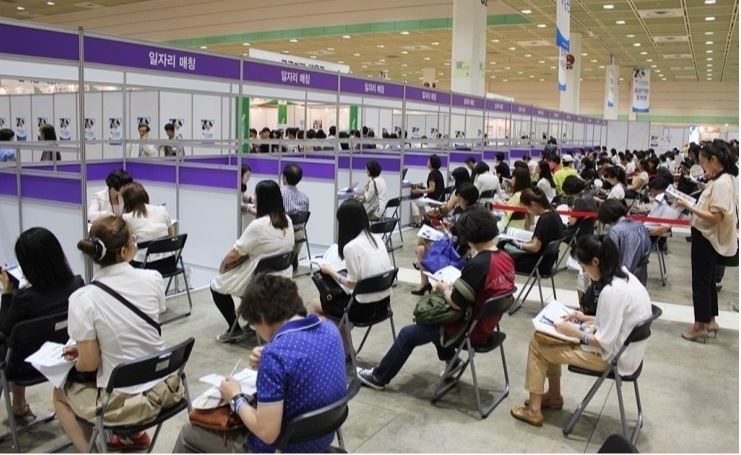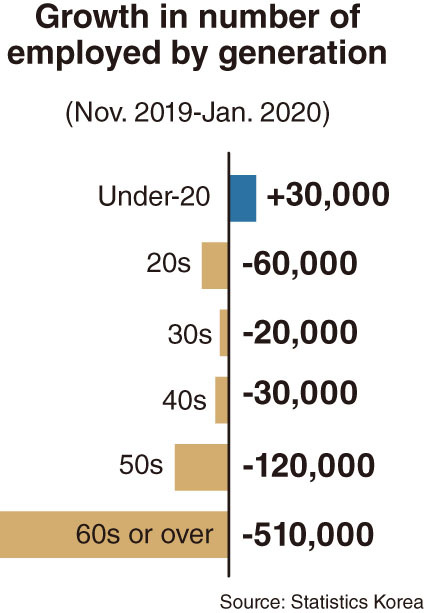[News Focus] Employment falls in almost all age groups
By Kim Yon-sePublished : Feb. 27, 2020 - 16:40

SEJONG -- The tight hiring market has been a point of contention over the past two or three years, though the Moon Jae-in administration has continued to express a strong commitment to job creation as often as possible.
Recent data from a government agency showed that people are still having difficulty holding jobs, which particularly has been witnessed among almost entire generations.
According to Statistics Korea, the number of employed people fell for the second consecutive month -- from 27.51 million in November 2019, 27.15 million in December 2019, and to 26.8 million in January 2020.
During the two-month period, the number of employed in their 20s dropped by about 60,000 to 3.75 million, those in their 30s by 20,000 to 5.51 million and those in their 40s by 30,000 to 6.45 million.
Those in their 50s and 60s or over also posted decline in the figures -- by 120,000 to 6.37 million and by 510,000 to 4.49 million.

Though the number of hired increased by 30,000 to 200,000 among the youngest group, aged between 15-19, the figure is relatively negligible, given a large portion of them are still studying or training period before entering the society.
The slack hiring performance pulled down the nation’s employment rate among the working-age population, aged 15-64, to 60 percent as of January, which is the lowest in 11 months since it stayed at 59.4 percent in February 2019.
“Formerly, the decrease in the number of employed was serious among a particular generation (40-somethings), who suffered continuous monthly falls for about two years between 2018 and 2019,” a job-recruitment agent said. “But the recent phase is that the decline is seen among all age groups, aged 20 or over.”
He said the critical situation is also seen from the sharply growing payouts of unemployment benefits by the government for the jobless.
The data held by the Korea Employment Information Service showed that unemployment benefits have continued to surge over the past three years -- reaching 5 trillion won ($4.1 billion) in 2017, 6.43 trillion won in 2018 and an all-time high of 8.07 trillion won in 2019.
The 2019 figure marked a 72.8 percent surge in only three years, compared with 2016, when the figure stood at 4.67 trillion won.
Further, compared with five years earlier -- in 2014, when benefits paid out amounted to 3.96 trillion won -- the 2019 payouts constituted a 103.7 percent increase.
Further, more and more South Koreans are suffering from unstable job conditions, as an increasing proportion are employed as not regular workers but nonregular workers.
Over the past two years, there has been a fall in the number of regular jobs -- positions with permanent contracts and consequently greater protections for workers.
According to a Statistics Korea database, the number of regular workers fell to 13.07 million as of August 2019, the most recent month for which data was available, down from 13.42 million two years earlier, or in August 2017.
In contrast, the number of nonregular workers has increased from 6.57 million in August 2017 to 7.48 million in August 2019. Nonregular workers are those whose contracts finish at a predetermined date.
This data indicates that the number of regular jobs fell by 350,000, while the number of nonregular jobs increased by more than 900,000 over the corresponding two years. President Moon took office in May 2017.
As a result, the proportion of nonregular workers among salaried employees has risen to 36.4 percent, the highest in 12 years since March 2007, when it reached 36.6 percent.
The government agency unveils the relevant data only once or twice per year per year, and the figure stayed under 33 percent between March 2013 and August 2016.
Government officials have clarified that the rapid growth in the number of nonregular jobs in 2019 was due to re-classification of 350,000-500,000 regular workers as nonregular workers.
They highlighted a new standard set by the International Labor Organization. But such a re-classification cannot fully explain the 900,000 increase in nonregular workers over two years.
By Kim Yon-se (kys@heraldcorp.com)



![[AtoZ into Korean mind] Humor in Korea: Navigating the line between what's funny and not](http://res.heraldm.com/phpwas/restmb_idxmake.php?idx=644&simg=/content/image/2024/04/22/20240422050642_0.jpg&u=)
![[Exclusive] Korean military set to ban iPhones over 'security' concerns](http://res.heraldm.com/phpwas/restmb_idxmake.php?idx=644&simg=/content/image/2024/04/23/20240423050599_0.jpg&u=20240423183955)



![[Graphic News] 77% of young Koreans still financially dependent](http://res.heraldm.com/phpwas/restmb_idxmake.php?idx=644&simg=/content/image/2024/04/22/20240422050762_0.gif&u=)
![[Herald Interview] Why Toss invited hackers to penetrate its system](http://res.heraldm.com/phpwas/restmb_idxmake.php?idx=644&simg=/content/image/2024/04/22/20240422050569_0.jpg&u=20240422150649)





![[Exclusive] Korean military to ban iPhones over security issues](http://res.heraldm.com/phpwas/restmb_idxmake.php?idx=652&simg=/content/image/2024/04/23/20240423050599_0.jpg&u=20240423183955)



![[Today’s K-pop] Ateez confirms US tour details](http://res.heraldm.com/phpwas/restmb_idxmake.php?idx=642&simg=/content/image/2024/04/23/20240423050700_0.jpg&u=)